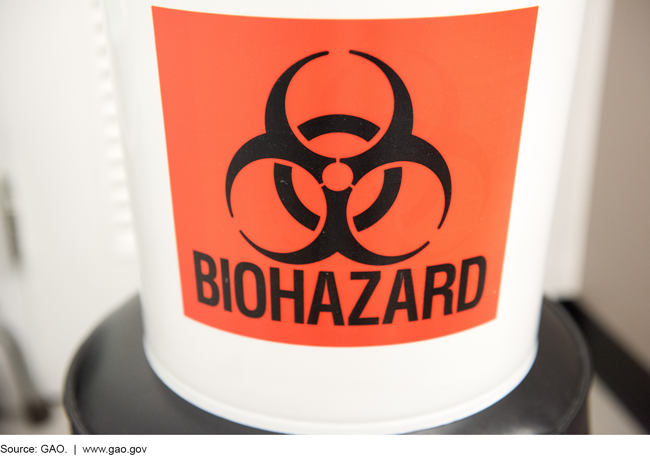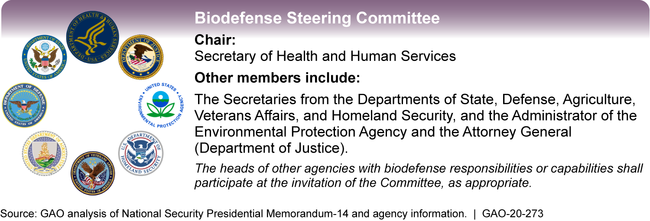National Biodefense Strategy: Additional Efforts Would Enhance Likelihood of Effective Implementation
Fast Facts
Biological threats range from naturally occurring diseases to deliberately created biological weapons. The National Biodefense Strategy, issued in 2018 along with guidance on how to implement it, spells out the nation’s plan to address these threats. Among other things, it calls for a joint effort by multiple agencies as well as private sector partners.
We reviewed how well the strategy has worked so far. We found there are no clear processes, roles, or responsibilities for joint decision making. We made 4 recommendations, including that Health and Human Services (the lead agency for the strategy) clearly document these factors.

Container marked as biohazard
Highlights
What GAO Found
Issued in September 2018, the National Biodefense Strategy (Strategy) and implementation plan, along with National Security Presidential Memorandum-14 (NSPM-14), are designed to enhance national biodefense capabilities. NSPM-14 established a governance structure composed of relevant federal agencies and chaired by the Secretary of Health and Human Services (HHS) to guide implementation. It also required federal agencies with biodefense responsibilities to collect and assess data on their biodefense activities to, among other things, identify gaps. The Strategy defined the scope of the biodefense enterprise (which includes partners at all levels of government and the private sector) and brought all of the biological threats—intentional, accidental, and naturally-occurring—together, establishing an overarching vision, goals, and objectives.
Membership of the Biodefense Steering Committee

There are a number of challenges, however, that could limit long-term implementation success. Among other things, there was no documented methodology or guidance for how data are to be analyzed to help the enterprise identify gaps and opportunities to leverage resources, including no guidance on how nonfederal capabilities are to be accounted for in the analysis. Many of the resources that compose national capbilities are not federal, so enterprise-wide assessment efforts should account for nonfederal capabilities.
Agency officials were also unsure how decisions would be made, especially if addressing gaps or opportunties to leverage resources involved redirecting resources across agency boundaries. Although HHS officials pointed to existing processes and directives for interagency decision making, GAO found there are no clear, detailed processes, roles, and responsibilities for joint decision-making, including how agencies will identify opportunities to leverage resources or who will make and enforce those decisions. As a result, questions remain about how this first-year effort to catalogue all existing activities will result in a decision-making approach that involves jointly defining and managing risk at the enterprise level. Without clearly documented methods, guidance, processes, and roles and responsibilities for enterprise-wide decision-making, the effort runs the risk of failing to move away from traditional mission stovepipes toward a strategic enterprise-wide approach that meaningfuly enhances national capabilities.
Why GAO Did This Study
GAO has reported on the inherent fragmented nature of the federal and nonfederal resources needed to protect the nation from potentially catastrophic biological threats. GAO called for a strategic approach to help the federal government better leverage resources and manage risk The White House issued the National Biodefense Strategy and the Presidential Memorandum on the Support for National Biodefense to promote a more efficient and coordinated biodefense enterprise.
The National Defense Authorization Act for Fiscal Year 2017 included a provision that GAO review the strategy. This report addresses the extent to which the Strategy and implementation efforts are designed to enhance national biodefense capabilities and any implementation challenges that exist.
GAO analyzed the Strategy, plans, and NSPM-14, and compared them to selected characteristics of GAO's work on effective national strategies, enterprise risk management, organizational transformation, and interagency coordination. GAO interviewed officials from the eight federal agencies that comprised the Biodefense Steering Committee to learn about early implementation.
Recommendations
GAO is making four recommendations to the Secretary of HHS, including working with other agencies to document methods for analysis and the processes, roles, and responsibilities for enterprise-wide decision making. HHS concurred with all the recommendations and described steps to implement them.
Recommendations for Executive Action
| Agency Affected | Recommendation | Status |
|---|---|---|
| Office of the Secretary for HHS |
Priority Rec.
The Secretary of HHS should direct the Biodefense Coordination Team to establish a plan that includes change management practices—such as strategies for feedback, communication, and education—to reinforce collaborative behaviors and enterprise-wide approaches and to help prevent early implementation challenges from becoming institutionalized. (Recommendation 1) |
The Biodefense Coordination Team no longer exists under the 2022 National Biodefense Strategy and responsibilities were not transferred to another entity. As part of our ongoing review of the updated National Biodefense Strategy, we have learned more details about how the governance structure and agencies' role and responsibilities have changed. Specifically, according to the 2022 National Biodefense Strategy, the White House now leads this effort. While HHS has taken some steps in collaboration with other federal agencies and departments, as of February 2024, HHS communicated that because of the change in governance structure for implementing the updated Strategy, they no longer have the authority to implement this recommendation. Therefore, we recommend that this recommendation be closed as no longer valid. We plan to continue to monitor efforts to address this recommendation through our ongoing review looking at the new biodefense plan and structure (job code 107148).
|
| Office of the Secretary for HHS |
Priority Rec.
The Secretary of HHS should direct the Biodefense Coordination Team to clearly document guidance and methods for analyzing the data collected from the agencies, including ensuring that nonfederal resources and capabilities are accounted for in the analysis. (Recommendation 2) |
The Biodefense Coordination Team no longer exists under the 2022 National Biodefense Strategy and responsibilities were not transferred to another entity. As part of our ongoing review of the updated National Biodefense Strategy, we have learned more details about how the governance structure and agencies' role and responsibilities have changed. Specifically, according to the 2022 National Biodefense Strategy, the White House now leads this effort. As of February 2024, HHS communicated that because of the change in governance structure for implementing the updated Strategy, they no longer have the authority to implement this recommendation. Therefore, we recommend that this recommendation be closed as no longer valid. We plan to continue to monitor efforts to address this recommendation through our ongoing review looking at the new biodefense plan and structure (job code 107148).
|
| Office of the Secretary for HHS |
Priority Rec.
The Secretary of HHS should direct the Biodefense Coordination Team to establish a resource plan to staff, support, and sustain its ongoing efforts. (Recommendation 3) |
We made this recommendation in February 2020. HHS agreed with our recommendation, but efforts HHS took did not address the intent of the recommendation. For example, HHS submitted budget requests to support its own implementation of the National Biodefense Strategy, but requests did not provide a detailed plan on how such budget requests would be used to staff, support, and sustain ongoing Strategy implementation efforts by the whole Biodefense Coordination Team (BCT). Establishing a resource plan is important because the BCT was comprised of over a dozen member departments and agencies, and feedback in 2019 and 2020 solicited by HHS indicated that many of the agencies did not feel adequately staffed to support the implementation activities of the Team. However, HHS's budget requests did not detail specific resources that may have been required of other members. In October 2022, the White House issued an updated National Biodefense Strategy and Implementation Plan. At the same time, it issued National Security Memorandum-15 (NSM-15), which established a new governance structure for implementing the 2022 National Biodefense Strategy. In May 2023, HHS told us that it and members of the BCT were deeply involved in the process to revise the Strategy and to develop the NSM-15. Drawing on the experience of the BCT, the new NSM-15 process for collecting data is intended to be less resource intensive. As such, HHS determined that a resource plan for the BCT was not necessary, specifically because that governance body no longer exists and the NSM-15 should require fewer resources to collect data.
|
| Office of the Secretary for HHS |
Priority Rec.
The Secretary of HHS should direct the Biodefense Coordination Team to clearly document agreed upon processes, roles, and responsibilities for making and enforcing enterprise-wide decisions. (Recommendation 4) |
In August 2020, the Biodefense Coordination Team finalized guidance titled "Biodefense Priority Setting Process to Support Implementation of the National Biodefense Strategy" with the goal of creating a systematic, structured, inclusive, and transparent process to inform the development of recommendations related to certain critical aspects of strategy implementation. The guidance documents a methodology for soliciting recommendations from all of the members of the Biodefense Coordination Team and for subsequently facilitating discussion and applying a weighted voting technique to arrive at priorities that have been vetted across the interagency group. This guidance was accompanied by charters for the interagency bodies involved in identifying budget priorities from the immediate working groups responsible for analyses of resources available and needed to implement the Strategy to the secretary-level steering committee that plays a review and approval role. Taken together, these documents should provide more clarity on enterprise-wide decision making to the interagency bodies. As a result, we are closing this recommendation as implemented.
|
